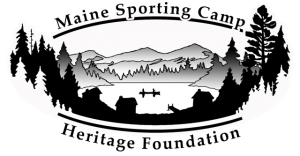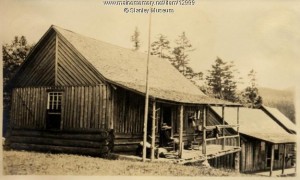The Foundation’s first priority is to assure that the land occupied by sporting camps will continue to be made available for use by commercial sporting camps. The Foundation’s acquisition activity focuses on the primary sporting camp lots, and to then provide long term leases for sporting camp use only – forever.
Secondly, the Foundation seeks to protect surrounding lands from commercial development through various conservation activities that include educating the public about the importance of conservation efforts to preserve Maine’s natural resources and the undeveloped, pristine surroundings that most sporting camps rely upon. These special places, the waters, wildlife, fisheries, scenic vistas and open spaces, are very important to the public. Sporting camps make it possible for many people to see and experience these natural resources.
It is therefore imperative that, first, the natural resources must be conserved, and second, the sporting camp must be preserved so the broader public can participate in and experience the natural environment.
The Foundation develops coalitions and partnerships with organizations whose primary missions involve land and wildlife conservation, and to draw their focus and resources into partnerships that will accomplish both the conservation goals, and the goals to improve sporting camps and local communities.
Conservation Purposes
The Foundation’s multi-faceted initiative is to protect the forestland and the waters they drain into from timber liquidation and real estate speculation while also setting the stage for future permanent conservation, community forest ownership, and community & economic benefits.
The Foundation’s goal is to conserve the wild open spaces surrounding sporting camps by preventing their loss due to over-development or habitat destruction, and to use the conservation itself to improve the area’s resource-based tourism and forestry economy.
The sporting camp institution dates back to the mid-1800’s. Their locations were specifically chosen at that time because some special natural resource was nearby. These resources are becoming rare and are rapidly being lost. The Foundation’s conservation thus begins with the lands, and then moves to the special occupants – the plants and wildlife (fish and fowl included).
Targeting Forestland Conservation
Maine’s expanse of contiguous forest that stretches from the White Mountains along the Maine-New Hampshire border, north to the Allagash Wilderness Waterway and east to the Downeast coast is truly unique. Known to most as the “Maine Woods,” it is valued as the state’s primary source of forest products, home to the state’s most revered outdoor recreation destinations, and an expansive unfragmented landscape supporting an array of wildlife found nowhere else in the eastern U.S. It encompasses approximately 12 million acres including most of the 10.5 million acres of unorganized territories unique in this day and age with no local government and few public roads, as well as adjacent forest lands in surrounding towns. It is an area with strong traditions and a rich history.
Since Penobscot Indian guides first led Henry David Thoreau on his exploration of the natural beauty of Mount Katahdin, Moosehead Lake, and the Penobscot River on hundred and fifty years ago, the Maine Woods have offered the finest of outdoor adventures, attracting recreationists from around the country and the globe. Fly-fishing for wild brook trout on a remote pond, paddling for a week on a backcountry river, hunting moose or staying in a century-old sporting camp are experiences that are plentiful throughout the Maine Woods and virtually impossible to find anywhere else in the eastern United States. These extraordinary recreation opportunities support an important segment of Maine’s tourism economy including outfitters and guides; inns, motels, restaurants and sporting camps; recreational vehicle and equipment stores, and many other enterprises that serve visitors to the Maine Woods.
The picture would not be complete without looking at the Maine Woods through a cultural lens, as the ancestral lands of Native American tribes including the Penobscot, Passamaquoddy, Maliseet and Micmac who sustainably manage their lands today in a manner that supports the cultural integrity and economic base of the tribes. The Maine Woods are also the backdrop for many Maine communities, like Jackman, Greenville, Fort Kent, Bethel, Rangeley, Millinocket and Grand Lake Stream whose heritage and economic vitality are intertwined with the surrounding woods. More broadly, the Maine Woods are indeed a part of the cultural fabric of Maine and the quality of life for its residents.
Northern Maine’s natural resources are its greatest assets. Conserving those assets is clearly a vital benefit to our quality of life and economic future. The Foundation’s goal is to conserve a sustainably managed forest landscape, which continues to produce wood products and protects ecological and cultural values, while maintaining and improving recreational opportunities. This will not only sustain a natural resource, but a way of life and institutions that have been a vital part of the state’s economy for 150 years.
The conservation of natural areas is crucial to sustaining the region’s tourism economy, outdoor recreation traditions, forest products industry and ecological integrity. These natural areas provide jobs in forest products industries and the region’s tourism economy.
Well-managed private forests open to public recreation bolster local and regional tourism economies – from hunting, trapping, fishing, hiking, wildlife-watching, snowmobiling and skiing to cultural-heritage-based attractions. Outdoor recreation alone draws billions of dollars into Maine’s northern region economy each year.
By conserving the lands, the Foundation will be maintaining or enhancing existing public access for the full spectrum of existing recreational uses, and attracting an increased number of recreational visitors to the region through selective investments in improved recreation facilities.
Targeting Wildlife Species
Each area will have its own unique resources and bio-diversity. These will be recorded as the Foundation’s database is developed. The Foundation will enlist the assistance of many partners to help identify and prioritize the specific species or resources. However, we can anticipate several major species issues in advance. For instance:
- Whitetail Deer – Once common and very much a part of Maine’s culture, deer populations have declined by nearly 90% in the northern regions of Maine where sporting camps are located. This is due to several factors, including habitat loss and predation. Most sporting camps have a Deer Wintering Area (DWA) nearby that most likely is not currently providing the quality of habitat it once did. The Foundation will develop a Deer Wintering Area Habitat Database, and will work with state agencies and forest landowners to creating appropriate management plans.
- Pine Martin – Martin are a member of the weasel family that has had declining populations due to changes in their preferred evergreen forest habitat. The Foundation works with state agencies and forest landowners to create appropriate management plans for areas where the martins are found.
- Canada Lynx – A threatened species in the United States, Maine is the southern edge of the lynx’s northwoods habitat and supports a small but viable population. Many sporting camps are within the vital habitat areas for these animals. The Foundation works with state agencies and forest landowners to create appropriate management plans for areas where the lynx are found.
- Loons & Bald Eagles – These birds are found in areas near sporting camps. Nesting sites for both are specially protected in Maine. These sites will be identified, and the Foundation will work with state agencies and forest landowners to creating appropriate management plans for assuring that nests are left undisturbed.
- Wild Brook Trout – Maine contains 97% of the remaining wild brook trout habitat east of the Mississippi River. Many sporting camps focus specifically on this species, as visitors come to Maine from very far away to fish for them. Unfortunately, development and invasive fish species is taking its toll. Occasionally an industrial activity damages the spawning waters for this cold water fish. The state of Maine has identified the major lakes where these fish thrive, and has launched an initiative to better protect the wild strains of this fish. These strains also include the rare blueback brook trout which thrives in only a few lakes, several of which are adjacent to a sporting camp. The Foundation works with state agencies and forest landowners in creating appropriate management plans for areas where wild brook trout are found.
- Others – Maine has habitats for many rare and endangered species of plants, animals, birds and fish. The list is too long to add here. Fortunately, the expertise to identify these species and their habitats is readily available through many of the partnerships we will develop, for instance through the Maine Natural Areas Program.
Research
Working with various partners (private and state) having specific expertise, the Foundation will work with sporting camps to develop a better inventory of the rare species and habitats in the area. We anticipate developing a database that will help bring the interest and skills of other partners whose mission is to protect those unique aspects of the environment.
This database will also be used to help the sporting camps and local communities learn to utilize these special resources in a sustainable way, and to share these resources with others, thereby improving their business opportunities by attracting those visitors to the region who desire to observe or experience the area.
Guidelines for Qualifying Conservation Priorities
The Foundation follows well established guidelines, including guidelines provided by the IRS, federal agencies, the state of Maine, the private conservation community, and foundations that provide financial support for conservation efforts. As stated in Internal Revenue Code § 170(h), the areas to be protected for “conservation purpose” will:
- Preserve the land areas for outdoor recreation by, or the education of, the general public;
- Protect of a relatively natural habitat of fish, wildlife, or plants, or similar ecosystem;
- Preserve open space (in this case, forest land) where such preservation is for the scenic enjoyment of the general public, or will yield a significant public benefit;
- Preserve an historically important land area or a certified historic structure.
These factors are founded in the “Uniform Conservation Act of 1981”, as amended.
In addition, the Foundation’s land conservation easement programs are oriented to meet the funding requirements of the US Department of Agriculture’s Forest Legacy program , and Maine’s “Land for Maine’s Future” program . Both delineate requirements for conservation, including public access provisions and ecosystem protection.
The Foundation’s land acquisition programs is also structured according to additional requirements, similar to those established by the “Trust for Public Lands ” which works to protect “natural lands” as well as “heritage lands.” Heritage Lands often include farm and ranch lands, as done by the Wyoming Stock Growers Agricultural Land Trust to preserve open grazing lands for ranchers.


